Keywords
|
| FHSS, PN Sequence Generator, BER, AWGN Channel. |
INTRODUCTION
|
| To improve the performance of short-range wireless communications, channel quality must be improved by avoiding interference and multi-path fading. Frequency hopping spread spectrum (FHSS) is a transmission technique where the carrier hops from frequency to frequency. For frequency hopping a mechanism must be designed so that the data can be transmitted in a clear channel and avoid congested channels. Adaptive frequency hopping is a system which is used to improve immunity toward frequency interference by avoiding using congested frequency channels in hopping sequence. Mathematical modelling is used to simulate and analyse the performance improvement by using frequency hopping spread spectrum with popular modulation schemes, and also the hopping channel situations are investigated. |
| A multiuser Time Division Multiple Access - Orthogonal Frequency Division Multiplexing (TDMA-OFDM) system, the evolution process of different radio interface proposal for the Universal Mobile Telecommunication System (UMTS) which is standardized to European telecommunication standard institute (ETSI). To fulfill the requirement the system uses OFDM technique in the transmitter and receiver [1]. |
| The FHSS transceiver is implemented for TDMA system; it uses the PN sequence for hopping from one carrier frequency to other carrier frequency. In this the optimal joint maximum likelihood estimator for time and frequency offset of the additive white Gaussian noise (AGSN) channel has been presented for broadcasting. It will be protected from fading effect in decoding at the receiver. |
| In narrow band signal estimation is not accurate as compare to the wide band OFDM system, in order to provide the more reliable communication the system utilizes the wide band signal, the frequency hopping spread spectrum transmitter will make the ISM band into number parts that is frequency slots, these slots separated by some MHz frequency. |
| A system is defined to be a spread spectrum system if it fulfills the following requirements |
| 1. The modulated signal occupies a more bandwidth than required minimum bandwidth necessary to send the data |
| 2. The spectrum spreading is accomplished by means of a wideband spread signal, often called a code signal, which is independent of data. |
| 3. At the receiver, de-spreading is accomplished using the same code sequence operating in synchronism with the transmitter [2]. |
| Certain application needs system to transmit the original information without a loss of information and make it difficult to the unwanted users to receive the original information. This is called secure communication. Such communication is very important in military applications where techniques called spread spectrum modulation is used. Even the spread spectrum modulation is used for commercial application also [3], [4]. The interference in the transmission channel may be unintentional interference caused because the user may be transmitting through that same channel. Sometimes the interference is created intentionally by a hostile transmitter to ‘jam’ the transmission. Those problems can be solved using spread spectrum modulation [5]. |
| A spread-spectrum transmission provides three main advantages: |
| 1) Avoids narrow band interference |
| 2) Difficult to intercept spread spectrum signals. |
| 3) Provides minimal interference when sharing the frequency band with other Conventional transmissions. |
| The two most common types of spread spectrum transmission are frequency hopping spread spectrum (FHSS) and direct sequence spread spectrum (DSSS). [2]. |
METHODOLOGY OR DESIGN FLOW
|
| Below flow graph shows the method or procedure of the project, and each block present in the flow graph is briefly explained below. |
| ? At first the requirement analysis will be carryout, the requirement as follows Matlab R2012B tool will use to work on this project. |
| ? In this case the overall system will be designed using number of blocks |
| ? In logic design the blocks will described using the logical elements means circuit diagram it helps to design the overall system by analyzing the logical diagrams. |
| ? The gate level model is analysed and then by using Matlab – simulink the FHSS Transceiver design will be carried. |
| ? The result of the model is tested and verified. |
| ? The lastly at the receiver side the bit error rate is calculated. |
OVERVIEW OF FHSS
|
| A. Architectural View of FHSS System |
| In modulator the baseband signal is combined with the hop frequency or carrier frequency generated by the frequency hopping block. The carrier frequency generated by this will be random since it is controlled by PN- sequence generator [6]. The modulated output will be sum of these two, which is spread over entire frequency band. At the receiver the demodulator gets the coded signal back from the spread spectrum signal. For this purpose the demodulator requires the same sequence which was used at the transmitting end. Hence the random sequence pattern generators at the transmitter and receiver side operate in synchronization with each other. The decoder at the receiver then gets the binary information sequence back. The received data and the original input data are given to error calculation block to calculate the error rate of the channel and it is displayed by using BER display. Figure (2) shows the top level block diagram of single user FHSS [7]. |
| B. Simulink Model for FHSS |
| The Frequency Hopping Spread Spectrum System simulink model is as show in figure 3, the input data is generated by using Bernoulli binary generator. The Bernoulli binary generator generates the binary values i.e 1’s and 0’s by using the Bernoulli expression. The output of binary generator is encoded by using the cyclic encoder and the form a binary 1’s and 0’s to a frame in order to make the transmission easier. The binary values are modulated using FSK which uses the carries as frequency hopping signal[8], then the signal is transmitted over Additive white Gaussian noise (AWGN)channel. And the transmitter output is obtained using FFT scope |
| At the receiver side the this signal is demodulated using the same Frequency hopping signal and obtained the frames and the frames are disassembled, then decoded the signal using cyclic decode and the BER (Bit Error Rate) is calculated using Error calculator and displayed by using BER display. |
| The result of the FHSS transmitter as shown in figure (4), there is spike in all the above figures that represent the data at the signal which is transmitted over AWGN Channel that hopes in the frequency range and the Bit error rate is calculated. |
CONCLUSION
|
| This project proposes a design and implementation of the frequency hopping spread spectrum transmitter and Receiver using Matlab – Simulink because whatever the previous paper which are done those have the limitations over small range communication. In order achieve this by using different technology like TDMA architecture which can be designed using FHSS system, this project is implemented on Matlab Simulink and the also we extend this project Implementation using FPGA Kit Vertex – 5. The transmission and reception of information along FHSS is planned and achieved. |
ACKNOWLEDGEMENT
|
| My sincere thanks to my guides Dr. M. Nagaraja, Associate Professor, Department of E&C, S.S.I.T Tumkur, Dr. M.Z Kurian HOD Dept of ECE SSIT Tumkur and Prof. Imran Rasheed, Asst Prof Dept of EEE, MSRSAS Bangalore for their guidance, constant encouragement and wholehearted support. |
Figures at a glance
|
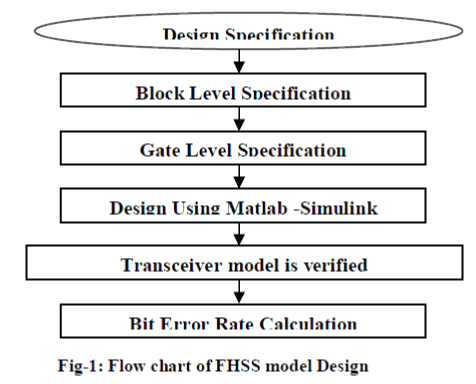 |
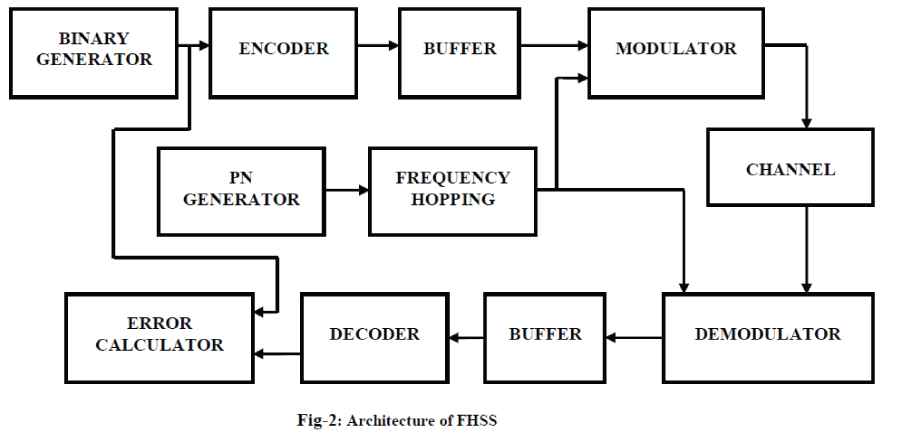 |
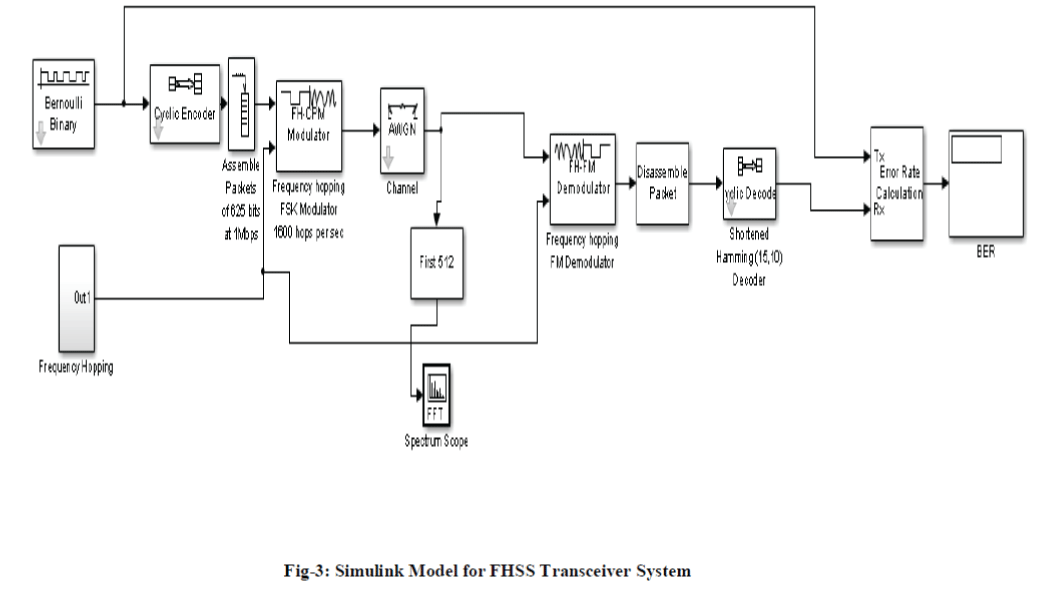 |
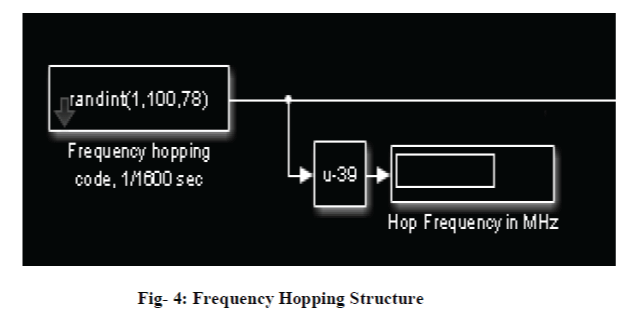 |
| Figure 1 |
Figure 2 |
Figure 3 |
Figure 4 |
 |
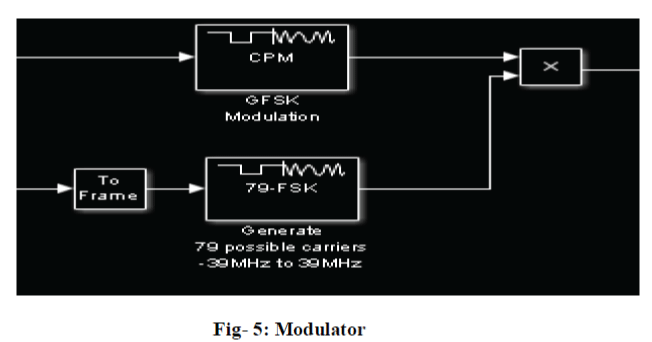 |
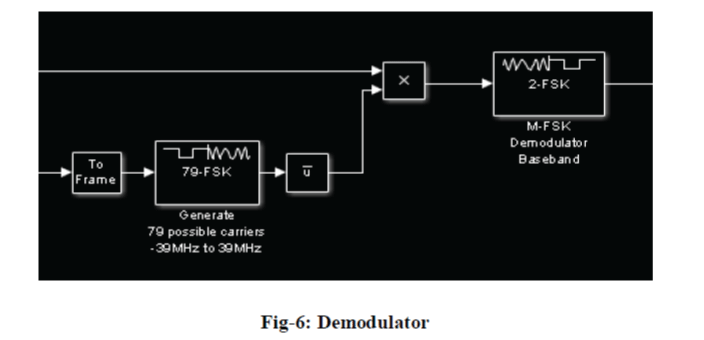 |
| Figure 4a |
Figure 5 |
Figure 6 |
|
| |
References
|
- Qi Ling, Tongtong Li, Zhi Ding (2007) ‘A Novel Concept: Message Driven Frequency Hopping (MDFH)’. IEEE International Conference onCommunications, Held 24-28 June, 5496 - 5501
- J. S. Chitode (2006) Text Book Name “Digital Communication” First Edition, Technical Publication.
- AbidYahya (2006) ‘Design and Develop Wireless System Using Frequency Hopping Spread Spectrum’. International Association of Engineers,Held 4-6 July, London
- Adeel Ahmad and RahatUllah (2012) ‘Efficient Transmission of Information using Transmission Code along FHSS’. International Journal ofComputer Applications, 40(9)
- An Liu, Peng Ning and Huaiyu Dai (2007), USD-FH: Jamming-resistant Wireless Communication using Frequency Hopping with UncoordinatedSeed Disclosure, North Carolina State University, Raleigh, NC
- Dantong Na, Weikang Zhao ‘Analysis and Design of Jamming System for Frequency Hopped Communications using BFSK based on Simulink’.Changchun Institute of Engineering Technology, Changchun China
- Yu Zhang, XueheZheng,Sen Yang, ‘Modeling and Performance Analysis of Frequency Hopping Spread Spectrum Communication System’,Beijing Institute of Technology Beijing, China
- Zhang Huaqing, ‘Design and performance analysis of frequency hopping sequences with given minimum gap’ Communication university of China, Beijing, China.
|